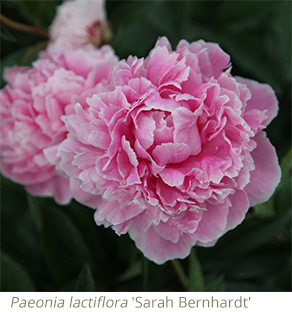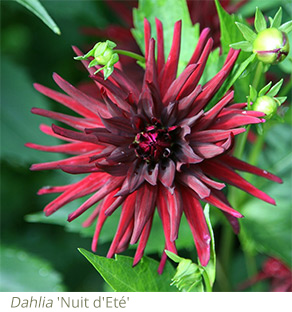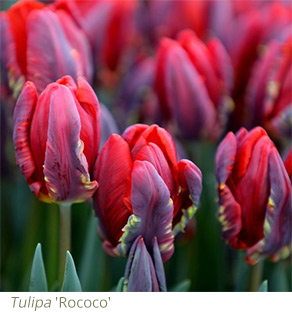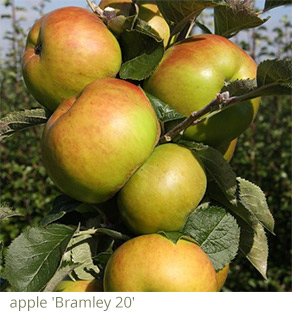This is the time of the year when you notice the gaps, but luckily there’s still time to do something about it because early autumn is the perfect planting season for woody plants. The soil’s still warm and the autumn rain and cooler air temperatures create perfect settling in conditions. It’s really worth considering investing in a mature specimen for instant eye appeal, rather than planting small and waiting for four of five years. You’ll end up planting one specimen and you’ll probably end up spending less in the long run, because it’s filled that gap. Mature plants are good value and they’re likely to do well.
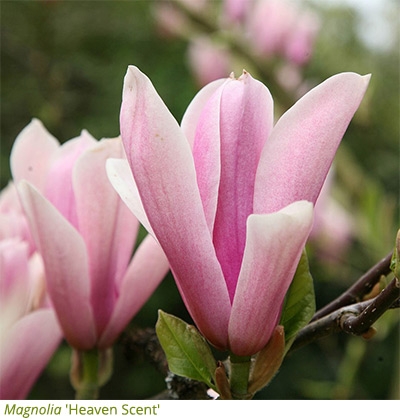 Every garden needs spring colour and magnolias provide it in such an elegant way. In small gardens Magnolia stellata, the one with the starry early spring flowers, is perfect because it’s more shrub than tree. It can be easily accommodated in smaller plots, or it can be containerised because it’s slow growing. The white starry flowers give this magnolia an ethereal look and, on a practical note, the gaps between the petals allow the cold air to escape. This avoids frost damage so the flowers don’t brown. Every garden needs spring colour and magnolias provide it in such an elegant way. In small gardens Magnolia stellata, the one with the starry early spring flowers, is perfect because it’s more shrub than tree. It can be easily accommodated in smaller plots, or it can be containerised because it’s slow growing. The white starry flowers give this magnolia an ethereal look and, on a practical note, the gaps between the petals allow the cold air to escape. This avoids frost damage so the flowers don’t brown.
If you want a more tree like magnolia, ‘Heaven Scent’ produces tulip-shaped, pale pink flowers flushed in deep pink, spread along bare branches in April. These are highly fragrant, so ‘Heaven Scent’ is perfect whether you’ve a small urban garden or a larger plot.
Magnolia ‘Susan’ has purple-pink tulip flowers in late-April and May and this American-bred magnolia, one of the so-called Seven Sisters or Little Girls, is one of the best small magnolias ever bred. ‘Susan’ flowers in May and often avoids all the frosts - and the dark flowers stand out against pale spring skies.
Magnolias are shallow rooted, so it’s best to foundation plant round them as they go in, because they resent root disturbance. ‘Heaven Scent’ and ‘Susan’ could be underplanted, on the outer edges, with dappled pink hellebores, or pulmonarias. ‘Blue Ensign’ produces contrasting cobalt-blue flowers held above plain green leaves. Or you could use ‘Opal’, a grey-blue pulmonaria with spotted foliage and this one makes a good clump. Another option is Brunnera macrophylla ‘Jack Frost’. In April the heart-shaped frosted foliage frames dainty blue sprays of flower. Whenever you’re planting around a tree, keep the planting simple. Don’t overshadow the tree.
Spring-flowering viburnums also provide a strong scent and V. x burkwoodii is a semi-evergreen with roundels of apple-blossom white flowers. These can appear in March and the heady, slightly spicy scent (almost as good as Daphne) carries even in cool conditions. The foliage is a glossy green with a paler underside and this easily grown viburnum has a branching habit so it’s perfect with woodlanders because this large shrub doesn’t cast deep shade.
 The more upright V. x bodnantense ‘Dawn’ is best planted on the outer edges. The tight clusters of mid-pink flowers have a hyacinth scent that’s particularly noticeable in late autumn when ‘Dawn’ begins to flower. She will continue whenever the weather’s clement enough through winter and then have a final flourish in March or April, depending on the weather. ‘Charles Lamont’ is a lighter pink version. The more upright V. x bodnantense ‘Dawn’ is best planted on the outer edges. The tight clusters of mid-pink flowers have a hyacinth scent that’s particularly noticeable in late autumn when ‘Dawn’ begins to flower. She will continue whenever the weather’s clement enough through winter and then have a final flourish in March or April, depending on the weather. ‘Charles Lamont’ is a lighter pink version.
Foliage matters too and Photinia x fraseri ‘Red Robin’ produces warm red new growth above rich green evergreen foliage so this evergreen shrub lights up a cool day. It’s easy to grow and versatile because specimens can be clipped into lollipops, trained into hedges or be allowed free rein. The warm red foliage sets off blues and miniature blue bulbs, such as Scilla siberica and rich blue Muscari armeniacum, creating a contrast. Photinia can be grown in the ground, or in pots.
You could get the same warm red tones from a new compact form of Heavenly bamboo, Nandina domestica obsessed (‘Seika’). A so-called bamboo, but in fact a member of the Berberis family, this Chinese plant is an evergreen given warm conditions. However it will shed its foliage in cool conditions and then the new spring foliage emerges red, matures to green and then colours up to lipstick-red in autumn. It performs best in a bright warm position and, in a good year, white flowers appear and these are followed by red berries. Mostly though, this is a foliage plant grown for its feathery, long lasting arrangement of red foliage.
You can also inject colour into autumn and summer borders using Cotinus coggygria ‘Royal Purple’, an airy shrub with wine-red almost circular foliage. This comes into leaf later than most shrubs and consequently hangs on to foliage late into the year. In warm positions frothy pinks flowers appear, giving this shrub the common name of smoke bush. Used with tall grasses, it adds a bolt of ruby-red and the foliage picks up bright pink flecks once temperatures fall. This shrub can be cut back hard in spring, should you want to produce a mound of larger leaves. However it’s too leggy for a container.
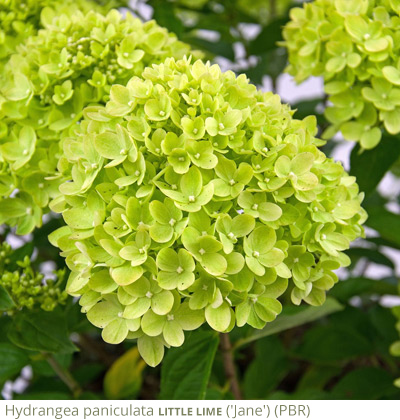 Summer-flowering shrubs can also be planted now and hydrangeas are riding high, but it’s the autumn-flowering subtle green and white hydrangeas that are in vogue and not the seaside pinks and blues. These are more drought tolerant and their graceful, conical heads of flower flow over the edges of large pots and many a good garden has several in a formal arrangement resembling an avenue. H. paniculata ‘Limelight’ produces conical heads of flower in late summer and, if you’re growing this in a pot, cut it back in April and then you’ll get fewer, but larger flowers. A new compact form of this, ‘little lime’, is even more suitable for a pot placed in a bright position. These hydrangeas like some shade and a cool root run and their fading flowers carry on into winter. Summer-flowering shrubs can also be planted now and hydrangeas are riding high, but it’s the autumn-flowering subtle green and white hydrangeas that are in vogue and not the seaside pinks and blues. These are more drought tolerant and their graceful, conical heads of flower flow over the edges of large pots and many a good garden has several in a formal arrangement resembling an avenue. H. paniculata ‘Limelight’ produces conical heads of flower in late summer and, if you’re growing this in a pot, cut it back in April and then you’ll get fewer, but larger flowers. A new compact form of this, ‘little lime’, is even more suitable for a pot placed in a bright position. These hydrangeas like some shade and a cool root run and their fading flowers carry on into winter.
If it’s summer flower and fragrance you’re after, the lemon scented white flowers of philadelphus, or mock orange, have perfect timing because they follow the first flush of roses. ‘Belle Etoile’ will reach four feet or more in height and form a rounded bush and each white flower has a blueberry blush in the middle, so this never looks stark or virginal. It has a refreshing scent, or you could enjoy the new double-flowered ‘Snowbelle’. This low growing Canadian-bred mock orange is compact and tidy and the double flowers still smell of oranges and lemons.
The old-fashioned name for philadelphus was syringa, although it’s lilac that officially bears this name. Confusion arose because these two plants were introduced at the same time when Busbecq, a Flemish diplomat working for the Austrians, introduced them into Vienna in 1562. Syringa means pipe and the hollow stems were used for pipes by the Turks. Some lilacs are highly scented and these are the ones to plant. Korean lilac, Syringa meyeri ‘Palibin’, bears delicate lavender-pink flowers in early summer when little else flowers. The scent is divine and this compact shrub will only reach four to five feet in height. The taller Syringa pubescens subsp. microphylla 'Superba' has rose-pink flowers in early spring and it sometimes repeats. These summer-flowering scented shrubs need to be pruned after flowering and the technique is to remove a third of the older, darker flowering wood.
 If it’s a small gap you’re plugging, plant something with good winter foliage. Bergenia ‘Overture’, a compact elephant’s ear that covers a foot or so, has crimson foliage in winter. Heucheras and x Heucherellas also have great winter leaves. The sumptuous black ones like ‘Black Pearl’ and ‘Obsidian’ can get lost against the soil so position these against evergreen foliage if possible, or mix them with a frosted heuchera. ‘Silver Scrolls’ is excellent, or you could use ‘Green Spice’ along with the black strappy grass Ophiopogon planiscapus ‘Nigrescens’. These all need warm sheltered locations in good light. x Heucherellas are more shade tolerant and they make excellent container plants. ‘Solar Eclipse’ has a burgundy-brown inner surrounded by a crisp bright green edge that picks up the green veining on the leaf. It's good in a pot or a partially shaded position. Heuchera and x Heucherella foliage makes real impact during winter and hardiness isn’t a problem. At the other end of the scale, they also survive hot weather as well. This is why they’re so popular in the heartland of America: they’re tough! If it’s a small gap you’re plugging, plant something with good winter foliage. Bergenia ‘Overture’, a compact elephant’s ear that covers a foot or so, has crimson foliage in winter. Heucheras and x Heucherellas also have great winter leaves. The sumptuous black ones like ‘Black Pearl’ and ‘Obsidian’ can get lost against the soil so position these against evergreen foliage if possible, or mix them with a frosted heuchera. ‘Silver Scrolls’ is excellent, or you could use ‘Green Spice’ along with the black strappy grass Ophiopogon planiscapus ‘Nigrescens’. These all need warm sheltered locations in good light. x Heucherellas are more shade tolerant and they make excellent container plants. ‘Solar Eclipse’ has a burgundy-brown inner surrounded by a crisp bright green edge that picks up the green veining on the leaf. It's good in a pot or a partially shaded position. Heuchera and x Heucherella foliage makes real impact during winter and hardiness isn’t a problem. At the other end of the scale, they also survive hot weather as well. This is why they’re so popular in the heartland of America: they’re tough!
|








